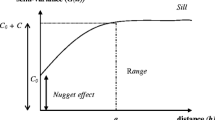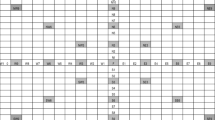Abstract
In this paper, we develop an epidemiological model with both environmental (primary infection from the environmental spores reservoir) and direct transmission (secondary infection from an infected host to a susceptible pod). This model simulates the spatiotemporal evolution of cocoa black pod disease caused by Phytophthora megakarya. Since reliable parameter estimation is a central issue for modeling realistic biological systems, we used a mechanistic–statistical approach to estimate model parameters from real observations of a specific cocoa plot. In addition, to refine numerical simulations of the pathosystem, data describing the shade intensity all over the plot were exploited and led to increased model predictions accuracy and also highlighted a higher number of infected pods located in areas of the plot with higher shading intensity. Recommendations in terms of promoting cocoa farming in systems with low shading intensity may be evident if these results are confirmed. Our results also highlight the importance of the environmental spore reservoir in black pod disease dynamics.














Similar content being viewed by others
References
Abboud C, Bonnefon O, Parent E, Soubeyrand S (2019) Dating and localizing an invasion from post-introduction data and a couple reaction–diffusion–absorption model. J Math Biol 79:765–789
Akaike H (1974) A new look at the statistical model identification. Trans Autom Control. 19(6):716–723
Akrofi AY, Amoako-Atta I, Assuah M, Asare K (2015) Black pod disease on cacao (Theobroma cacao, L) in Ghana: spread of Phytophthora megakarya and role of economic plants in the disease epidemiology. Crop Prot 72:66–75
Ashyraliyev M, Fomekong-Nanfack Y, Kaandorp JA, Blom JG (2009) Parameter estimation for biochemical models. Syst Biol 276:886–902
Avelino J, Vílchez S, Segura-Escobar MB, Brenes-Loaiza MA, de Virginio Filho E, de Virginio Filho E M, Casanoves F (2020) Shade tree Chloroleucon eurycyclum promotes coffee leaf rust by reducing uredospore wash-off by rain. Crop Prot 129:0261–2194
Babin R, Ten Hoopen GM, Cilas C, Enjalric F, Yede Gendre P, Lumaret JP (2010) Impact of shade on the spatial distribution of Sahlbergella singularis in traditional cocoa agroforests. Agric For Entomol 12(1):69–79
Berliner LM (2003) Physical-statistical modeling in geophysics. J Geophys Res 108:8776
Bos MM, Steffan-Dewenter I, Tscharntke T (2006) Shade tree management affects fruit abortion, insect pests and pathogens of cacao. Agroecology, Gottingen University, Waldweg 26, D-37073 Gottingen, Germany
Bousset L, Jumel S, Garreta V, Picault H, Soubeyrand S (2015) Transmission of Leptosphaeria maculans from a cropping season to the following one. Ann Appl Biol 166(3):530–543
Brasier CM, Griffin MJ, Ward MR, Idowu OL, Taylor B, Adedoyin SF (1981) Epidemiology of Phytophthora on Cocoa in Nigeria: Final Report of the International Cocoa Black Pod Research Project. Phytopathological Papers. Commonwealth Mycological Institute, Kew, Surrey-London
Brunel N (2008) Parameter estimation of ODE’s via nonparametric estimators. Electron J Stati 2:1242–1267
Butler DR (1980) Dew and thermal lag: measurements and estimates of wetness duration on cocoa pods. Q.J.R. Meteorol Soc 106:539–550
Chou IC, Voit EO (2009) Recent developments in parameter estimation and structure identification of biochemical and genomic systems. Math Biosci 219:57–83
Cressie N, Wikle CK (2011) Statistics for spatio-temporal data. Wiley, Hoboken
Deberdt P, Mfegue CV, Tondje PR, Bon MC, Ducamp M, Hurard C, Begoude BAD, Ndoumbe-Nkeng M, Hebbar PK, Cilas C (2007) Impact of environmental factors, chemical fungicide and biological control on cacao pod production dynamics and black pod disease in Cameroon. Biol Control 44:149–159
Djidjou-Demasse R, Moury B, Fabre F (2017) Mosaics often outperform pyramids: insights from a model comparing strategies for the deployment of plant resistance genes against viruses in agricultural landscapes. New Phytol 216:239–253
Efron B, Tibshirani RJ (1993) An introduction to the bootstrap. Chapman and Hall, New York
Lewis PE, Ward JP (1991) The finite element method principles and applications. Loughborough University of Technology. Addison-Wesley Publishing Company, New York
Li P, Vu QD (2013) Identification of parameter correlations for parameter estimation in dynamic biological models. BMC Syst Biol 7(1):1–12
Li Z, Osborne M, Prvan T (2005) Parameter estimation in ordinary differential equations. IMA J Numer Anal 25:264–285
Liliacci G, Khammash M (2010) Parameter estimation and model selection in computational biology. PLoS Comput Biol 6(3):1000696
Meeker WQ, Escobar LA (1995) Teaching about approximate confidence regions based on maximum likelihood estimation. Am Stat 49(1):48–53
Mouen Bedimo JA, Njiayouom I, Bieysse D, Ndoumbè Nkeng M, Cilas C, Nottéghem JL (2008) Effect of shade on arabica coffee berry disease development: toward an agroforestry system to reduce disease impact. Phytopathology 98:1320–1325
Ndoumbè-Nkeng M, Efombagn MIB, Bidzanga NL, Sache I, Cilas C (2017) Spatio-temporal dynamics on a plot scale of cocoa black pod rot caused by Phytophthora megakarya in Cameroon. Eur J Plant Pathol 147:579–590
Ndoungue MM, Petchayo S, Techou Z, Nana W, Nembot FCG, Fontem AD, Ten Hoopen GM (2018) The impact of soil treatments on black pod rot (caused by Phytophthora megakarya) of cacao in Cameroon. Biol Control 123:9–17
Nembot C, Takam Soh P, ten Hoopen GM, Dumont Y (2018) Modeling the temporal evolution of cocoa black pod rot disease caused by Phytophthora megakarya. Math Methods Appl Sci 41(18):8816–8843
Nembot C, Takam Soh P, Ambang Z, ten Hoopen GM, Dumont Y (2017) On the use of Mathematical Modelling to study the impact of phytosanitation on cocoa black pod disease caused by Phytophthora megakarya. International Symposium on Cocoa Research (ISCR), Lima, Peru, 13–17 November 2017
Ngo Bieng MA, Babin R, ten Hoopen GM, Cilas C (2010) Spatial pattern analysis of tropical agroforests: methods for ecological and agronomical issues. Poster presented at the XIth ESA Congress Agro2010 Montpellier, Montpellier, France, 29 August–3 September
Ngo Bieng M, Gidoin C, Avelino J, Cilas C, Deheuvels O, Wery J (2013) Diversity and spatial clustering of shade trees affect cacao yield and pathogen pressure in Costa Rican agroforests. Basic Appl Ecol 14:329–336
Nyasse S, Efombagn MIB, Kebe BI, Tahi M, Despreaux D, Cilas C (2007) Integrated management of Phytophthora diseases on cocoa Theobroma cacao L impact of plant breeding on pod rot incidence. Crop Prot 26:40–45
Pao CV (1992) Parabolic boundary-value problems. Nonlinear parabolic and elliptic equations. Springer, Boston
Peacock SJ, Krkošek M, Lewis MA, Lele S (2017) Study design and parameter estimability for spatial and temporal ecological models. Ecol Evol 7(2):762–770
Puig AS, Ali S, Strem M, Sicher R, Gutierrez OA, Bailey BA (2018) The differential influence of temperature on Phytophthora megakarya and Phytophthora palmivora pod lesion expansion, mycelia growth, gene expression, and metabolite profiles. Physiol Mol Plant Pathol 102:95–112
Raue A, Kreutz C, Maiwald T, Bachmann J, Schilling M, Klingmüller U, Timmer J (2009) Structural and practical identifiability analysis of partially observable dynamical models by exploiting the profile likelihood. Bioinformatics 25:1923–1929
Roques L, soubeyrand S, Rousselet J (2011) A-statistical-reaction–difusion approach for analyzing expansion processes. J Theor Biol 274:43–51
Ristaino JB, Gumpertz ML (2000) New frontiers in the study of dispersal and spatial analysis of epidemics caused by species in the genus Phytophthora. Annu Rev Phytopathol 38:541–576
Soubeyrand S, Roques L (2014) Parameter estimation for reaction–diffusion models of biological invasions. Popul Ecol 56:427–434
Takam Soh P, Ndoumbè-Nkeng M, Sache I, Nguema EN, Gwet H, Chadoeuf J (2013) Development stage-dependent susceptibility of cocoa fruit to pod rot caused by Phytophthora megakarya. Eur J Plant Pathol 135(2):363–370
Ten Hoopen GM, Sounigo O, Babin R, Yede Dikwe G, Cilas C (2010) Spatial and temporal analysis of a Phytophthora megakarya epidemic in a plantation in the centre region of Cameroon. Proceedings of the 16th International Cocoa Research Conference 16–21 November 2009, Denpasar-Bali, Indonesia (ISBN 978-065-959-5), pp 683–687
Tremblay M, Wallach D (2004) Comparison of parameter estimation methods for crop models. Agronomie 24:351–365
Turchin P (1998) Quantitative analysis of of movement. Sunderlend (mass): sinauer assoc. In: Murray JD (ed) Mathematical Biology. Third edition interdisciplinary Applied Mathematics. Springer, New York
Wikle CK (2003) Hierarchical models in environmental science. Int Stat Rev 71:181–199
Yaglom AM (1987) Correlation theory of stationary and related random functions. Basic results, vol 1. Springer, Berlin, p 526
Acknowledgements
The first author is grateful to the DP Agroforesterie Cameroon, the French Government, and the French Embassy in Yaounde (SCAC), Cameroon for logistical and financial support during the preparation of this manuscript and also to the CETIC Yaoundé.
Authors together are very grateful to the experimental design initiators and all the data providers in the field, Olivier Sounigo, Yede, Maybelline Escalante, the farmer René, and Victor Ondoa, Benoit Owona, Maurice Douandji and Junior Zomo.
Author information
Authors and Affiliations
Corresponding author
Additional information
Publisher's Note
Springer Nature remains neutral with regard to jurisdictional claims in published maps and institutional affiliations.
Supplementary Information
Below is the link to the electronic supplementary material.
Appendices
Appendix A
In this appendix, we provide numerical simulations for susceptible pod compartment S (Fig. 15) and spores produced by infected pods \(P_1\) (Fig. 16) for the set of parameters \(\hat{\theta }\).
Appendix B
In this Appendix, we provide estimation results (\(\hat{\theta '}\)) for the “benchmark” estimation where we define \(P_2^0\) as a piecewise constant function. We also present the data histograms for the spatiotemporal raw residual analysis for the two estimation strategies.
-
Estimation results with \(P_2^0\) defined as a piecewise constant function.
The “benchmark” estimation of model parameters through the optimization function led to convergence after around 3000 iterations. The optimal value computed for the log-likelihood function is \(-7.2923e+04\), and the corresponding set of parameters \( \hat{\theta '}\) (with the corresponding asymptotic standard errors) are given in Table 5.
-
Raw residual analysis for the two estimation strategies.
Rights and permissions
About this article
Cite this article
Nembot Fomba, C.G., ten Hoopen, G.M., Soubeyrand, S. et al. Parameter Estimation in a PDE Model for the Spatial Spread of Cocoa Black Pod Disease. Bull Math Biol 83, 101 (2021). https://doi.org/10.1007/s11538-021-00934-z
Received:
Accepted:
Published:
DOI: https://doi.org/10.1007/s11538-021-00934-z








